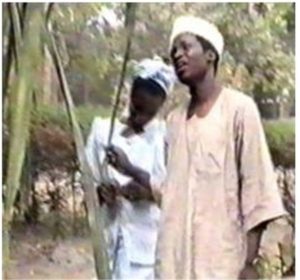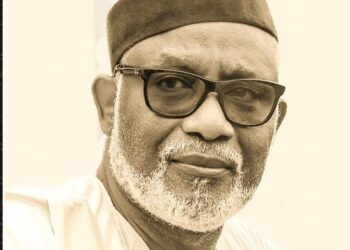
As noted earlier, the drama group, Tumbin Giwa led the way to commercial Kannywood in 1990, and other drama groups soon joined suit in trying to produce an independent home video. In this trajectory, the next group was Jigon Hausa Drama Club which produced a home video in 1993 and which provided the template for defining characteristics of commercial Hausa home video. It was Munkar, and was the first Hausa home video with a mimed singing – Hindi cinema style – although there was no dancing and no music. Considering the Hausa youth fixation with Hindi cinema, it was only a matter of time before this cinematic strategy became part of Hausa film motif. The way was already laid by Dausayin Soyayya TV film, and followed by Sidiya Baƙar Indiya dancing mimes to Hindi songs in amateur video films.
Although this home video set the pace for the inclusion of mimed singing (and later dancing) in Hausa films, the producer of the video, Khalid Musa, in a retrospective interview in 2003, had cause to revise his opinion of the inclusion of the song sequence in the video, almost ten years after the video. As he stated,
(trans) I started the trend (of singing in Hausa home videos) with Munkar which was the first Hausa home video with a song sequence. It opened up the doors for others to follow. Admitted, we did it, although in retrospect I can defend our strategy of including song sequence in Munkar by arguing that the song was strongly thematic to the storyline. I would say song sequences are not Hausa literature, nor are they reflective of Hausa culture. They are styles we borrowed, and I regretted doing it. If I had known that the issue of song sequences will become Damatul Kubra in Hausa home videos, we would certainly not have used it in that situation (in Munkar)
(Interview with Khalid Musa, producer, Munkar, Duniyar Fim magazine, January 2004, p. 47)
Munkar focuses attention on young prostitutes in Kano and the various strategies a group of concerned youth adopted to redeem the prostitutes and wean them away from such life. While a love story, it nevertheless had a strong and clear message about youth reformation.
Munkar was followed in 1994 by a cinema release of Ado Ahmad Gidan Dabino’s In Da So Da Ƙauna, and released under Tauraruwa Drama Group umbrella. The home video was an adaptation of the perhaps the most successful contemporary Hausa novel of similar title and brought forth a persistent social problem among the Muslim Hausa — forced marriage. This home video was also the first with a specifically created sound track containing Hausa lyrics and modern music, although there was no dancing. Interestingly enough, both Munkar (Khalid Musa and Bala Anas Babinlata) and In Da So Da Ƙauna were the works of established Hausa novelists who migrated into the Home video medium.
The use of “modern”, essentially Casio keyboard mini synthesizer in In Da So Da Ƙauna was incidental, and yet it was the basis of subsequent use of this musical instrument in Hausa home videos. The initial soundtrack for In Da So Da Ƙauna was composed with Hausa traditional musical instruments by the Ƙoroso Entertainment ensemble housed at the Kano State History and Culture Bureau. It featured the Fulani sarewa (flute) accompanied by drumming and a string of round pierced calabash tops that were shaken to the accompaniment of the drumming. It was this music that accompanied the film when it was shown throughout cinema houses in Northern Nigeria, as was the practice then.
However, when the video was screened at the Dawud Cinema in Maiduguri, Borno State, it was pirated, and soon enough a bootleg of the tape was making rounds in various markets. Ado Ahmad Gidan Dabino, the producer, was upset, but since there was little he could do, he decided to release his own official video of the home video in 1994, and also decided to include deleted scenes and other changes, as well as compose a different soundtrack, in order to make the second version as different from the bootleg version as possible. It was in the process of seeking a new sound for the home video that he came across Nasir Usman Ishaq Gwale, an artist with residency at the Kano State History and Culture Bureau.
Nasir was given a toy Casio organ in 1985 — when he was still in senior high school — by his brother, Bello Usman Ishaq, a resident artist with the HCB. When Nasir finished high school in 1986, he honed his skills, as it were, in music by forming a smallish ensemble that revolved around the Casio organ, providing an alternative form of entertainment for youth in and around Kano metropolis, mainly at functions, ceremonies and events. In 1988 he was employed as a resident artist at the History and Culture Bureau Kano and actually drew most of the cover pictures for the emerging Hausa novelists.
Earlier, in 1985 an African-American researcher, Richard Donald Smith, a flutist and then a lecturer at the United Nations International School, New York, visited the HCB and the following year, in 1986, he brought a gift of Casiotone MT-140 to the bureau. Nasir immediately started playing around with it and soon enough perfected it enough to further enrich his informal musical ensemble.
The History and Culture Bureau also plays host to other ensembles, particularly that formed by a school teacher who was trained in Sudan and also formed a band based on Sudanese music styles. One of their greatest hits was Halimatu Sadiya which in the late 1980s changed the pattern of popular entertainment in Kano and made it clear that the future lies with organs and synthesizers, rather than traditional Hausa instruments, especially among the youth. All these contributed to enrich Nasir’s musical repertoire. Under the tutelage of his teacher at the Bureau, Musa Ahmed, and with help from his friend Mukhtar Kwanzuma (keyboardist), and Shu’aibu Idris “Lilisco”— a former champion street disco dancer — also of the performing arts division, a more or less official ensemble was formed by 1993.
When Ado Ahmad Gidan Dabino was looking for a new sound to accompany the video release of In Da So Da Ƙauna by then Nasir Usman Ishaq Gwale had become a well-sought after keyboardist and was commissioned to compose the soundtrack. It was this soundtrack that was used in the “official” video release of In Da So Da Ƙauna in 1995. It was, therefore, the first Hausa home video with a modern music soundtrack. Its earlier version was also the first as well as last (so far) to use traditional instruments in its soundtrack. With the success of the official home video of In Da So DaƘauna, the Casio/Yamaha keyboard simply took over and became the voice of Hausa home video playback music.
By now the independent producers have started emerging, and the novelist Bala Anas Babinlata’s Tsuntsu Mai Wayo, released in 1994 signaled the future. In 1995, Ɗan Azimi Baba, another well-established novelist, decided to convert his novel, Rikicin Duniya, which he wrote in 1992, into a home video. However, a video film with similar name had already been released in 1991. In a spirit of co-operation, Ɗan Azimi re-titled his own video Bakandamiyar Rikicin Duniya.
So far, the home video revolution was a Kano phenomenon — encouraged by the existence of long-established drama clubs since 1970s, vibrant television houses (NTA and CTV 67) in the 1980s, and an all-pervading commercial hub center for production, distribution and consumption of any product. Thus the massive success of the contemporary Hausa novel, contemptuously labeled Kano Market Literature by critics from about 1980 all provide a combustible mixture for the emergence of screenplay writers who converted their novels into home video scripts and started adapting them for videos. Indeed, Bala Anas Babinlata says, in numerous discussions, that he started writing exclusively with the intention of converting his novels into a home video dramas when the opportunity presented itself. The producers were necessarily forced to use the video format because of the high cost of celluloid reels and their inability to purchase (and more importantly, recoup their investment) the professional equipment full-fledged professional film gear needed for professional quality production.
* Abdalla Uba Adamu is a double-Professor (of Science Education, and Media Studies) at Bayero University, Kano. He is a former Vice-Chancellor of the National Open University of Nigeria (NOUN)




